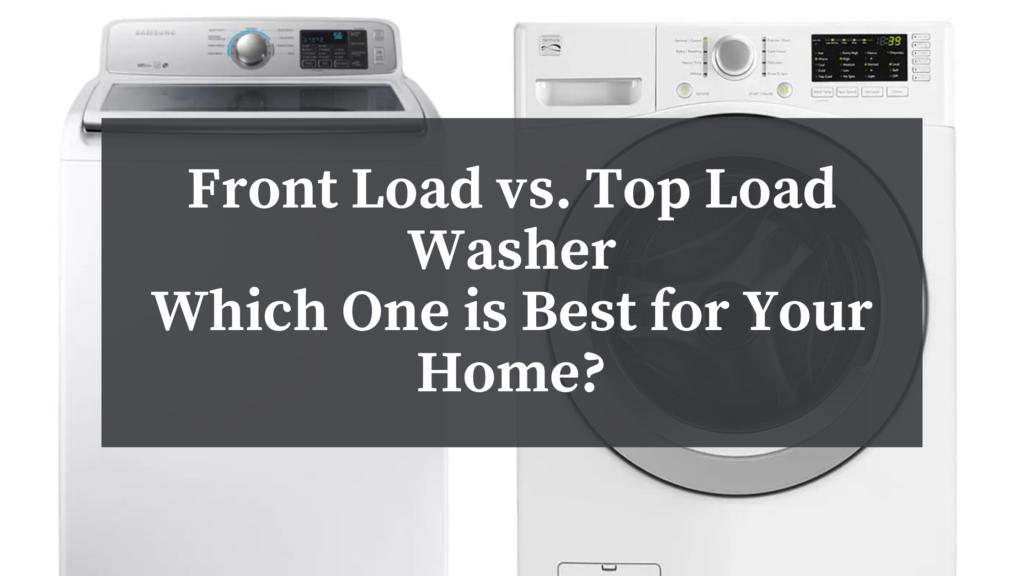
Choosing a washer is about more than just picking a style—it’s about finding the best fit for your home, lifestyle, and laundry routine. Should you go for a front load washer known for its efficiency and fabric care, or a top load washer favored for its convenience and speed?
To help you decide, we’re breaking down the key differences between front load and top load washers so you can choose the best option for your space and needs.
1. Space & Layout Considerations
Your laundry room setup plays a big role in determining which type of washer works best.
Front Load Washers
✔ Space-saving—stackable with a dryer to maximize floor space.
✔ Side-opening design allows for under-counter installation.
Top Load Washers
✔ Requires more vertical space due to the upward-opening lid.
✔ Works best in larger laundry rooms with side-by-side placement.
Best for: If your laundry area is compact or you need to stack your washer and dryer, a front load washer is the better choice.
2. Cleaning Performance & Fabric Care
The way each washer cleans your clothes can impact both effectiveness and fabric longevity.
Front Load Washers
✔ Use tumbling and gravity to clean—gentle yet effective.
✔ Distribute detergent and water evenly, ideal for delicate fabrics.
✔ Higher spin speeds extract more water, reducing drying time.
Top Load Washers
✔ Use either an agitator (a central spindle that scrubs clothes) or an impeller (a low-profile disc that moves clothes around).
✔ Agitators clean aggressively, great for tough stains but rougher on fabrics.
✔ Impellers are gentler but may not clean as deeply as agitators.
💡 Pro Tip: If using a top load washer for delicate fabrics, place them in a mesh laundry bag for added protection.
3. Capacity & Load Size
How much laundry do you typically wash at once? Capacity matters, especially for large households.
Front Load Washers
✔ Generally hold up to 5 cubic feet—sufficient for most homes.
✔ Even detergent distribution makes them great for mixed loads.
Top Load Washers
✔ Agitator models tend to have smaller capacities.
✔ Impeller models can exceed 5 cubic feet, making them ideal for washing bulky items like comforters.
Best for: If you frequently wash large loads, an impeller-style top load washer offers the most space.
4. Ease of Use & Comfort
Front Load Washers
✔ Require bending to load/unload clothes.
✔ Solution: Use a pedestal to elevate the washer for added comfort and storage.
Top Load Washers
✔ Easier to load since they sit at waist height—no bending needed.
✔ Allow you to add clothes mid-cycle, unlike most front load models.
Best for: If bending is a concern, a top load washer offers a more comfortable user experience.
5. Water & Energy Efficiency
If sustainability and lower utility bills are a priority, efficiency matters.
Front Load Washers
✔ Use less water by tumbling clothes instead of fully submerging them.
✔ Higher spin speeds remove more moisture, cutting down drying time.
Top Load Washers
✔ Agitator models use the most water, as clothes must be fully submerged.
✔ Impeller models use less water than agitators but still more than front load washers.
💡 Analogy: A front load washer is like a shower—efficient with water while still providing a thorough clean. A top load washer is like a bath—more water, but not necessarily a better wash.
6. Cleaning & Maintenance
All washers require regular upkeep, but front load models need extra attention.
Front Load Washers
✔ The door gasket can trap moisture, leading to mold or mildew.
✔ Maintenance Tip: Wipe down the gasket weekly and leave the door slightly open to prevent odors.
✔ Some newer models feature self-cleaning cycles and built-in vent systems to combat mildew buildup.
Top Load Washers
✔ Easier to keep clean, though agitators may need occasional deep cleaning.
✔ Many models now include self-cleaning cycles for added convenience.
Best for: If you prefer minimal maintenance, a top load washer may be the better choice.
7. Quick Comparison: Pros & Cons
Front Load Washers
✅ Pros:
✔ Stackable—saves space.
✔ Uses less water & energy—more efficient.
✔ Gentler on fabrics—great for delicates.
✔ Faster drying times—higher spin speeds remove more moisture.
❌ Cons:
✖ Requires more maintenance (door gasket needs regular cleaning).
✖ Bending required (unless using a pedestal).
Top Load Washers
✅ Pros:
✔ Faster cycle times—ideal for busy households.
✔ Easier to load/unload—no bending down.
✔ Can handle large loads—especially impeller models.
❌ Cons:
✖ Uses more water & energy than front loaders.
✖ Not stackable—takes up more floor space.
✖ Agitator models can be rough on fabrics.
Final Verdict: Which Washer is Best for You?
Choose a Front Load Washer if…
✔ You have limited space and need a stackable option.
✔ You want energy efficiency and lower water usage.
✔ You have delicate fabrics that require gentle care.
Choose a Top Load Washer if…
✔ You prioritize faster wash cycles and ease of use.
✔ You frequently wash bulky items like blankets.
✔ You prefer a low-maintenance washer.
Both styles have their advantages, and the best choice depends on your laundry habits and home setup.
🔎 Still unsure? Visit BSC Culinary’s showroom to explore our selection of high-performance washers and find the perfect fit for your home!
